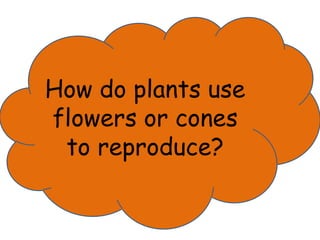Plants use flowers or cones to reproduce
•Download as PPT, PDF•
2 likes•4,955 views
grade 3 science lesson by Mrs. Aisha
Report
Share
Report
Share

Recommended
More Related Content
What's hot
What's hot (20)
Similar to Plants use flowers or cones to reproduce
Similar to Plants use flowers or cones to reproduce (20)
More from Noura Ishnawer
More from Noura Ishnawer (20)
Recently uploaded
Ultrasound color Doppler imaging has been routinely used for the diagnosis of cardiovascular diseases, enabling real-time flow visualization through the Doppler effect. Yet, its inability to provide true flow velocity vectors due to its one-dimensional detection limits its efficacy. To overcome this limitation, various VFI schemes, including multi-angle beams, speckle tracking, and transverse oscillation, have been explored, with some already available commercially. However, many of these methods still rely on autocorrelation, which poses inherent issues such as underestimation, aliasing, and the need for large ensemble sizes. Conversely, speckle-tracking-based VFI enables lateral velocity estimation but suffers from significantly lower accuracy compared to axial velocity measurements.
To address these challenges, we have presented a speckle-tracking-based VFI approach utilizing multi-angle ultrafast plane wave imaging. Our approach involves estimating axial velocity components projected onto individual steered plane waves, which are then combined to derive the velocity vector. Additionally, we've introduced a VFI visualization technique with high spatial and temporal resolutions capable of tracking flow particle trajectories.
Simulation and flow phantom experiments demonstrate that the proposed VFI method outperforms both speckle-tracking-based VFI and autocorrelation VFI counterparts by at least a factor of three. Furthermore, in vivo measurements on carotid arteries using the Prodigy ultrasound scanner demonstrate the effectiveness of our approach compared to existing methods, providing a more robust imaging tool for hemodynamic studies.
Learning objectives:
- Understand fundamental limitations of color Doppler imaging.
- Understand principles behind advanced vector flow imaging techniques.
- Familiarize with the ultrasound speckle tracking technique and its implications in flow imaging.
- Explore experiments conducted using multi-angle plane wave ultrafast imaging, specifically utilizing the pulse-sequence mode on a 128-channel ultrasound research platform. (May 9, 2024) Enhanced Ultrafast Vector Flow Imaging (VFI) Using Multi-Angle ...

(May 9, 2024) Enhanced Ultrafast Vector Flow Imaging (VFI) Using Multi-Angle ...Scintica Instrumentation
Antibiotics are medicines that fight infections caused by bacteria in humans and animals by either killing the bacteria or making it difficult for the bacteria to grow and multiply. Bacteria are germsABHISHEK ANTIBIOTICS PPT MICROBIOLOGY // USES OF ANTIOBIOTICS TYPES OF ANTIB...

ABHISHEK ANTIBIOTICS PPT MICROBIOLOGY // USES OF ANTIOBIOTICS TYPES OF ANTIB...ABHISHEK SONI NIMT INSTITUTE OF MEDICAL AND PARAMEDCIAL SCIENCES , GOVT PG COLLEGE NOIDA
Recently uploaded (20)
(May 9, 2024) Enhanced Ultrafast Vector Flow Imaging (VFI) Using Multi-Angle ...

(May 9, 2024) Enhanced Ultrafast Vector Flow Imaging (VFI) Using Multi-Angle ...
FAIRSpectra - Enabling the FAIRification of Analytical Science

FAIRSpectra - Enabling the FAIRification of Analytical Science
POGONATUM : morphology, anatomy, reproduction etc.

POGONATUM : morphology, anatomy, reproduction etc.
Module for Grade 9 for Asynchronous/Distance learning

Module for Grade 9 for Asynchronous/Distance learning
Efficient spin-up of Earth System Models usingsequence acceleration

Efficient spin-up of Earth System Models usingsequence acceleration
Site specific recombination and transposition.........pdf

Site specific recombination and transposition.........pdf
ABHISHEK ANTIBIOTICS PPT MICROBIOLOGY // USES OF ANTIOBIOTICS TYPES OF ANTIB...

ABHISHEK ANTIBIOTICS PPT MICROBIOLOGY // USES OF ANTIOBIOTICS TYPES OF ANTIB...
Climate Change Impacts on Terrestrial and Aquatic Ecosystems.pptx

Climate Change Impacts on Terrestrial and Aquatic Ecosystems.pptx
Plants use flowers or cones to reproduce
- 1. How do plants use flowers or cones to reproduce?
- 3. reproduction make seeds that grow into new plants. Plants can reproduce: grow stems and roots that grow into new plants.
- 4. When plants reproduce, they make more of the same kind. Maple trees produce seeds. These seeds can grow into new maple trees.
- 5. 1-Each seed carries information from the parent plants. 2-The seed uses this information and food stored from the parent plant in the seed to grow into a new plant. 3-The new plant will be like its parents.
- 6. 4- After seeds are produced , they may scatter or move away from the parent plant. This gives the new plant more room to grow.
- 7. Parts of a flower petal This part Makes pollen Pollen helps form seeds
- 10. Pollination happens when animals or wind move pollen to the part of the flower that makes seeds. Animals or wind can pollinate, or carry pollen to another flower.
- 11. After pollination, seeds form near the center of the flower. Another part, fruit, often grows around the seed to protect it.
- 12. How seeds grow seeds need air, water, and the right temperature to germinate, or begin to grow.
- 14. 1- As the seedling (young plant) grows, it grows out of the soil. 2- Leaves grow from the stem. 3- The leaves use sunlight to make sugar for food. 5- The seedling can grow into an adult plant that has flowers. 6- The flowers are pollinated and new seeds form. 7- If these new seeds germinate, they can grow into new plants.
- 16. Seed coat Seed leaf developing plant leaf embryo
- 17. How cones help plants Small pollen cones
- 18. Large seed cones
- 19. 1- wind blows pollen from small pollen cones to large seed cones. 2- pollen sticks to the large seed cones. 3- seeds begin to grow under scales of the seed cones. 4- seeds become fully developed and float to the ground. 5- each seed can grow into a new plant.
